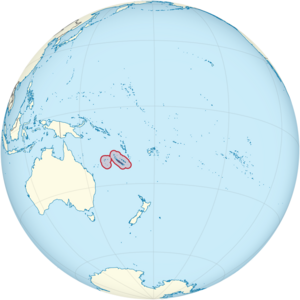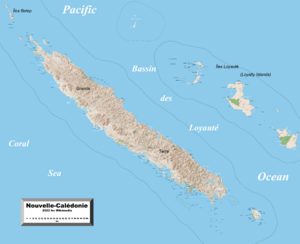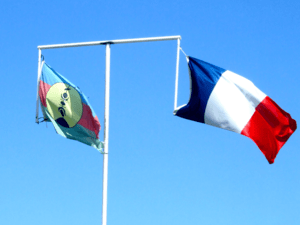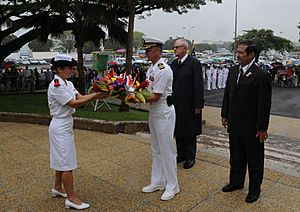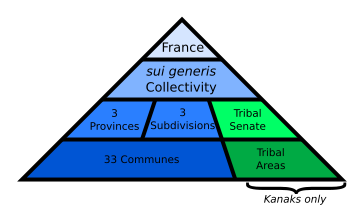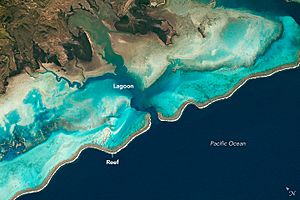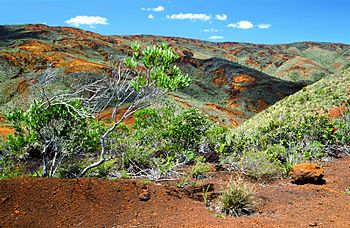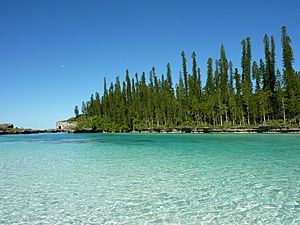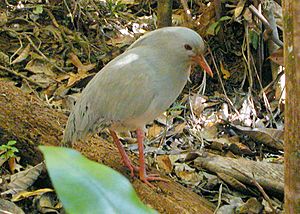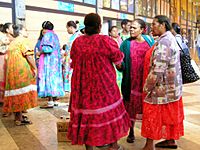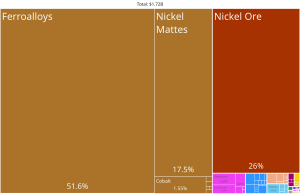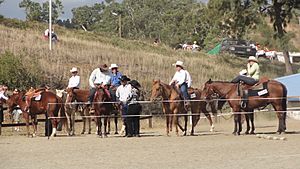New Caledonia facts for kids
Quick facts for kids
New Caledonia
Nouvelle-Calédonie (French)
|
|||
|---|---|---|---|
|
|||
| Motto(s):
English: "Land of speech, land of sharing"
|
|||
| Anthem: La Marseillaise ("The Marseillaise") "Soyons unis, devenons frères" |
|||
|
Location of New Caledonia
|
|||
| Sovereign state | |||
| Annexed by France | 24 September 1853 | ||
| Overseas territory | 1946 | ||
| Nouméa Accord | 5 May 1998 | ||
| Capital and largest city
|
Nouméa 22°16′S 166°28′E / 22.267°S 166.467°E |
||
| Official languages | French | ||
| Recognised regional languages |
|
||
| Demonym(s) |
|
||
| Government | Devolved parliamentary dependency | ||
| Emmanuel Macron | |||
| Louis Le Franc | |||
| Louis Mapou | |||
|
• President of the Congress
|
Veylma Falaeo | ||
|
• President of the Customary Senate
|
Yvon Kona | ||
| Legislature | Congress | ||
| Area | |||
|
• Total
|
18,575 km2 (7,172 sq mi) | ||
|
• Land
|
18,275 km2 (7,056 sq mi) | ||
|
• Water (%)
|
1.6 | ||
| Highest elevation
(Mont Panie)
|
1,628 m (5,341 ft) | ||
| Population | |||
|
• 2019 census
|
271,407 (184th) | ||
|
• Density
|
14.5/km2 (37.6/sq mi) (200th) | ||
| GDP (nominal) | 2019 estimate | ||
|
• Total
|
US$9.44 billion | ||
|
• Per capita
|
US$34,780 | ||
| Currency | CFP franc (₣) (XPF) | ||
| Time zone | UTC+11:00 | ||
| Driving side | right | ||
| Calling code | +687 | ||
| ISO 3166 code |
|
||
| Internet TLD | .nc | ||
New Caledonia (kal-IH-doh-NEE-ə; French: Nouvelle-Calédonie) is a special territory of overseas France. It is located in the southwest Pacific Ocean. This group of islands is south of Vanuatu and east of Australia.
The main island is called Grande Terre. Other important islands include the Loyalty Islands and the Isle of Pines. People in New Caledonia, especially locals, often call Grande Terre "Le Caillou", which means "the pebble".
New Caledonia has a land area of about 18,576 square kilometers. It is divided into three areas called provinces. The North and South Provinces are on the main island. The Loyalty Islands Province is made up of three islands off the east coast.
In 2019, New Caledonia had a population of 271,407 people. These people come from many different backgrounds. In the North and Loyalty Islands, most people are Kanak, who are the native people. The South Province has many people of European and Polynesian descent. The capital city of New Caledonia is Nouméa.
Contents
History of New Caledonia
New Caledonia was once part of a huge landmass called Zealandia. This land broke away from an even bigger supercontinent called Gondwana millions of years ago. The first people arrived in New Caledonia around 1600–500 BCE. They were part of the Lapita culture. These people were very good at sailing and farming.
The first European to see New Caledonia was British explorer James Cook. He spotted it on September 4, 1774. He named it "New Caledonia" because the island's northeast reminded him of Scotland. Other explorers visited later, and contact with ships became more common after 1840. This was because traders were interested in sandalwood.
When the sandalwood trade slowed down, a new business started. It was called "blackbirding". This was a way of tricking or forcing people from New Caledonia and other Pacific islands to work as laborers, almost like slaves, on sugar farms in Fiji and Queensland, Australia.
Missionaries from the London Missionary Society and the Marist Brothers arrived in the 1840s.
French Rule Begins
On September 24, 1853, France officially took control of New Caledonia. This was ordered by Emperor Napoleon III. The capital city, Port-de-France, was founded in 1854.
New Caledonia became a place where France sent prisoners starting in 1864. Many criminals and political prisoners were sent there until 1897. This included people arrested after the failed Paris Commune in 1871, like Louise Michel. Most of these political prisoners returned to France later.
In 1864, a valuable metal called nickel was found. Mining for nickel began in 1876. To work in the mines, France brought in workers from nearby islands and from countries like Japan and Vietnam. The French government also tried to get more Europeans to move there, but it wasn't very successful.
The native Kanak people were kept out of the French economy and mining jobs. They were forced to live in special areas called reservations. This led to a big fight in 1878. A Kanak leader named Ataï led a war that killed many French and Kanak people. Another uprising happened in 1917.
New diseases brought by Europeans, like smallpox and measles, caused many native people to die. The Kanak population dropped a lot and didn't start to grow again until the 1930s.
During World War II, in 1940, New Caledonia decided to support the Free French government. Many men from the territory volunteered to serve overseas.
In 1942, New Caledonia became an important base for the Allied forces. The United States Navy moved its main South Pacific fleet base to Nouméa. The fleet that stopped the Japanese Navy in the Battle of the Coral Sea in May 1942 was based here. At one point, there were as many as 50,000 American troops in New Caledonia, which was about the same as the local population.
Becoming an Overseas Territory
In 1946, New Caledonia became an overseas territory of France. By 1953, all New Caledonians were given French citizenship.
Over the years, more Europeans and Polynesians moved to New Caledonia. The native Kanak people became a smaller part of the total population, even though they were still the largest single group.
Between 1976 and 1988, there were serious conflicts and violence. This was between the French government and the Kanak independence movement. In 1988, the Matignon Agreements were signed, which brought a period of peace.
The Nouméa Accord, signed in 1998, planned for a 20-year period. During this time, more power would slowly be given to the local government. This agreement also set the stage for votes on whether New Caledonia should become fully independent from France.
In 2008, six lagoons of the New Caledonian barrier reef were added to the UNESCO World Heritage List. This reef is the longest continuous barrier reef system in the world.
Three referendums (votes) on independence have been held.
- The first was on November 4, 2018. Most voters chose to stay with France.
- The second was on October 4, 2020. Again, most voters chose to remain part of France.
- The third was on December 12, 2021. This vote was boycotted by many who wanted independence. As a result, 96% of those who voted chose to stay with France.
New Caledonia has started to use its own symbols, like an anthem and a motto. In 2010, the local government voted to fly the Kanak flag (which represents the independence movement) alongside the French flag. This means New Caledonia is one of the few places in the world with two official flags.
Government and Politics
New Caledonia is a special territory of France. Its citizens have French nationality and can vote in French elections. It is governed by a 54-member Territorial Congress. This group is made up of members from the three provincial assemblies. The French government is represented by a High Commissioner. New Caledonia also has two representatives and two senators in the French Parliament.
Customary Authority
The Kanak people have their own traditional system of authority. This includes clans led by chiefs, which form tribes. These tribes are grouped into customary chiefdoms.
The Customary Senate is a group of traditional Kanak councils. It helps make decisions about laws that affect Kanak identity. It also advises on laws about Kanak customs and land. A new president is chosen each year, and the role rotates among the eight customary areas.
Kanak people can use their traditional authorities for civil matters like marriage, adoption, and land issues. The French government usually respects these decisions. However, traditional rules about punishment are not used if they go against France's human rights laws.
Military and Police
The Armed Forces of New Caledonia (FANC) have about 2,000 soldiers. Most of these soldiers are on short-term deployments from mainland France.
The naval forces include several French Navy ships. These help patrol the waters around New Caledonia. The French Air Force also has transport planes and helicopters stationed here.
About 855 police officers from the National Gendarmerie are also in New Caledonia. They are divided into different units across the islands.
Administrative Divisions
New Caledonia is divided into three provinces:
- South Province: Its capital is Nouméa. It has a population of 203,142 people (2019).
- North Province: Its capital is Koné. It has a population of 49,912 people (2019).
- Loyalty Islands Province: Its capital is Lifou. It has a population of 18,353 people (2019).
New Caledonia is also divided into 33 smaller areas called communes (municipalities). One commune, Poya, is split between two provinces.
Geography and Climate
New Caledonia is part of Zealandia, a piece of the ancient supercontinent Gondwana. It is believed that New Caledonia separated from Australia about 66 million years ago.
The main island has a central mountain range. The highest peaks are Mont Panié (1,629 meters) in the north and Mont Humboldt (1,618 meters) in the southeast. The east coast is very green with lots of plants. The west coast is drier, with large grasslands good for farming. Many areas along this coast are rich in minerals.
The Diahot River is the longest river in New Caledonia, flowing for about 100 kilometers. Most of the island has wet evergreen forests. The New Caledonian lagoon is one of the largest in the world, covering 24,000 square kilometers. The lagoon and the surrounding New Caledonia Barrier Reef became a UNESCO World Heritage Site in 2008. This is because of its amazing beauty and sea life.
Climate
New Caledonia has a tropical climate. It has a hot and humid season from November to March, with temperatures around 27 to 30 degrees Celsius. The cooler, dry season is from June to August, with temperatures between 20 and 23 degrees Celsius. The ocean and trade winds help to keep the humidity down. The average yearly temperature is 23 degrees Celsius.
Rainfall varies a lot across the island. Some areas get three times more rain than others. Tropical storms and cyclones can happen between December and April. These can bring very strong winds and heavy rain.
Environment and Wildlife
New Caledonia is home to many unique plants and animals. It has the richest variety of species per square kilometer in the world. This is because the central mountain range on Grande Terre has created many different habitats and micro-climates.
New Caledonia produces a lot of carbon dioxide per person, mainly because of its nickel industry. Protecting New Caledonia's unique environment from fires, building, farming, and mining is very important.
Unique Plants

The plants and animals of New Caledonia come from ancient species that were isolated when the land broke away from Gondwana. This means many types of plants and animals are found only here.
New Caledonia has more unique tropical gymnosperm species than any other similar region. Out of 44 native gymnosperm species, 43 are found nowhere else. This includes the only known parasitic gymnosperm. Also, 13 of the 35 known species of Araucaria trees are unique to New Caledonia.
The world's oldest living group of flowering plants, Amborella trichopoda, is also found here.
The world's largest living fern, Cyathea intermedia, is also unique to New Caledonia. It grows very fast on the east coast.
New Caledonia is also one of five places where southern beeches (Nothofagus) grow naturally. Five species are found here.
The unique soils of New Caledonia, rich in metals from mining areas, have become a safe place for many native plants. These plants are adapted to the toxic minerals, which helps prevent foreign plants from taking over.
Unique Animals
New Caledonia has a wide variety of animals. Over 100 bird species live here, and 24 of them are found nowhere else. One special bird is the New Caledonian crow. These crows are known for their amazing intelligence and their ability to make tools, which is very rare in the animal kingdom.
The kagu is another unique bird. It cannot fly but can run very fast and use its wings to climb or glide. Its call sounds like a dog's bark.
There are 11 unique fish species and 14 unique types of crabs and shrimp in New Caledonia's rivers and lakes. The nautilus, a creature thought to be a living fossil, lives in the Pacific waters around New Caledonia. The surrounding waters also have many different kinds of marine fish.
Even with many birds, reptiles, and fish, New Caledonia has very few mammal species. Only nine are known, and six of them are unique to the islands.
Some animals in New Caledonia are known for their large size. The Ducula goliath is the largest tree-dwelling pigeon. The Rhacodactylus leachianus is the largest gecko in the world. The Phoboscincus bocourti is a large lizard that was thought to be extinct but was found again in 2003.
Many animals that lived in New Caledonia before humans arrived are now extinct. These include a large bird called Sylviornis and a giant horned turtle called Meiolania.
People and Languages
| Historical populations | ||
|---|---|---|
| Year | Pop. | ±% p.a. |
| 1956 | 68,480 | — |
| 1963 | 86,519 | +3.72% |
| 1969 | 100,579 | +2.60% |
| 1976 | 133,233 | +4.03% |
| 1983 | 145,368 | +1.26% |
| 1989 | 164,173 | +2.06% |
| 1996 | 196,836 | +2.61% |
| 2009 | 245,580 | +1.68% |
| 2014 | 268,767 | +1.79% |
| 2019 | 271,407 | +0.19% |
| ISEE | ||
In 2019, New Caledonia had 271,407 people. Most of them, about two out of three, live in the greater Nouméa area. About 78% of the people were born in New Caledonia.
Ethnic Groups
| Ethnic Groups in New Caledonia (2019 Census) | ||||
|---|---|---|---|---|
| Ethnic Groups | percent | |||
| Kanak | 41.2% | |||
| European | 24.1% | |||
| "Caledonian" or not stated | 7.5% | |||
| Mixed | 11.3% | |||
| Wallisian/Futunian | 8.3% | |||
| Tahitian | 2.0% | |||
| Indonesian | 1.4% | |||
| Ni-Vanuatu | 0.9% | |||
| Vietnamese | 0.8% | |||
| Other Asian | 0.4% | |||
| Other | 2.1% | |||
The largest ethnic group is the Kanak, who are the native people of New Caledonia. They make up about 41.2% of the population. Their social life is based on clans.
About 24.1% of the population is European. Many of these are native-born New Caledonians with French family roots. Others are from mainland France. There are also people from Wallis and Futuna, Indonesia, Tahiti, Vanuatu, and Vietnam. About 11.3% of the population is of mixed race.
-
Rodeos (here at the annual fair of Bourail) are part of Caldoche culture.
Languages
French is the official language and is spoken by almost everyone in New Caledonia.
There are 28 different Kanak languages spoken in New Caledonia. These are part of the Oceanic group of languages. Some of these languages can be studied in schools, and an academy works to promote them. The most widely spoken native languages are Drehu, Nengone, and Paicî.
Other languages spoken by immigrant groups include Wallisian, Futunian, Tahitian, Javanese, Vietnamese, and Chinese.
Religion
Religion in New Caledonia according to the Global Religious Landscape survey by the Pew Forum, 2012 Christianity (85.2%) No religion (10.4%) Islam (2.8%) Buddhism (0.6%) Folk religion (0.2%) Others (0.8%)
The main religion in New Caledonia is Christianity. About half of the people are Roman Catholic. Many different Protestant churches are also present, and their numbers are growing. There are also over 6,000 Muslims.
Education
Education in New Caledonia follows the French school system. Primary education is managed by the three provinces. Secondary education is also being transferred to the provinces. Most schools are in Nouméa. Education is required for children starting at age six.
New Caledonia's main university is the University of New Caledonia. It is in Nouméa and offers many different programs. Many students also go to France for their studies.
Economy
New Caledonia has one of the largest economies in the South Pacific. Its economy was worth about US$9.44 billion in 2019. The average income per person was US$34,780 in 2019. However, there is a big difference in wealth between the richer South Province and the less developed North and Loyalty Islands.
The currency used is the CFP franc, which is linked to the euro.
The economy grew well in the early 2010s because of rising nickel prices. However, growth slowed down later in the decade due to problems in the nickel industry and uncertainty from the independence votes. In 2011, exports were about US$2.11 billion, with 75.6% being nickel products. Imports were much higher, at US$5.22 billion.
France provides a lot of financial support, which helps the economy. Tourism is not very developed, with about 100,000 visitors each year. Much of the land is not good for farming, so about 20% of imports are food.
Nickel Industry

New Caledonia has about 25% of the world's nickel resources. The nickel industry has faced challenges, including drops in nickel prices. However, New Caledonia remains the world's fourth largest nickel producer.
In 2021, Tesla made a deal with the Goro Mine in New Caledonia. Tesla agreed to help with production and sustainability, and to buy nickel for its car batteries. This deal is expected to help the local economy and create jobs.
Culture
Wood carving is an important art form in New Caledonia. It shows the beliefs of the traditional tribal society. Carvings include totems, masks, and special arrows that decorate the roofs of Kanak houses. Basketry is a craft often practiced by women, who make everyday items.
The Jean-Marie Tjibaou Cultural Centre, designed by architect Renzo Piano, opened in 1998. It is a famous symbol of Kanak culture.
Kaneka is a local music style that started in the 1980s. It is inspired by reggae.
The Mwâ Ka is a 12-meter tall totem pole that was put up in 2005. It remembers when France took control of New Caledonia.
Media
Les Nouvelles Calédoniennes is the only daily newspaper in New Caledonia.
There are five radio stations, including the public broadcaster RFO radio Nouvelle-Calédonie. Two stations, Radio Djiido and Radio Rythmes Bleus, are mainly for the different Kanak groups.
For television, there are several French channels available. A local channel called NCTV started in 2013.
Sports
New Caledonia hosts a round of the FIA Asia Pacific Rally Championship (APRC), which is a big car racing event.
The New Caledonia football team joined FIFA in 2004. They have won the South Pacific Games five times. Christian Karembeu is a famous New Caledonian former football player who won the World Cup with France. The under-17 team played in the FIFA under 17 World Cup in 2017.
Basketball is also very popular. New Caledonia's national team has won many medals in the Oceania region.
Horse racing and women's cricket matches are also well-liked.
The "Tour Cycliste de Nouvelle-Calédonie" is a multi-day bicycle race held in October. It attracts riders from many countries.
The New Caledonia Handball team won the Oceania Handball Nations Cup in 2008.
The Internationaux de Nouvelle-Calédonie is a tennis tournament held in January. Players often compete here to get ready for the Australian Open.
The New Caledonia women's national volleyball team has won gold medals several times.
Cuisine
New Caledonian food often uses rice, fish, and root vegetables like taro. Fresh tropical fruits are not as common as in other Pacific nations. A traditional meal is called bougna. Fish, taro, bananas, and other seafood are wrapped in banana leaves. Then, they are buried with hot rocks to cook slowly. After cooking, they are dug up and eaten.
Transport
La Tontouta International Airport is the main airport. It connects New Caledonia with cities like Paris, Tokyo, Sydney, and Auckland. Most flights within New Caledonia are operated by Aircalin. Cruise ships arrive at the Gare Maritime in Nouméa. A boat called Havannah travels to Vanuatu once a month.
New Caledonia has a road network that includes several main territorial routes (RT). These roads connect different parts of the islands.
See also
 In Spanish: Nueva Caledonia para niños
In Spanish: Nueva Caledonia para niños



